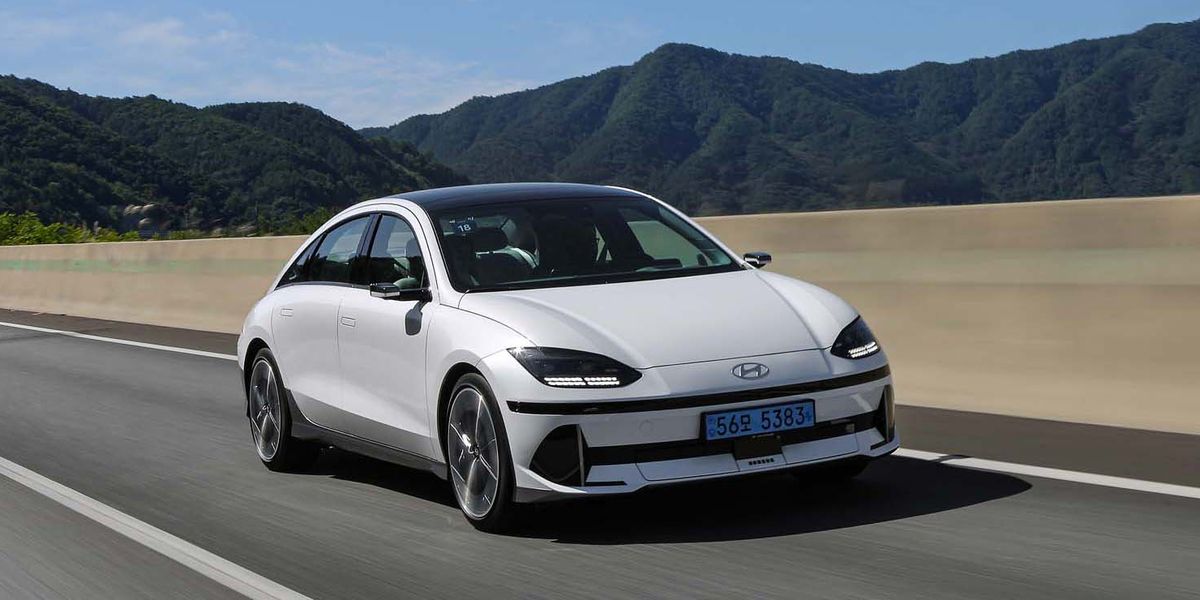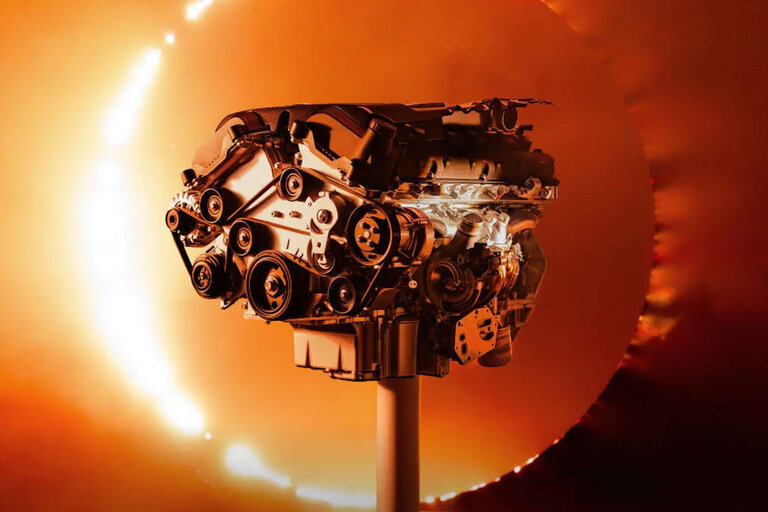
The 2023 Hyundai Ioniq 6 is smooth as a river rock and, at the same time, very square. Both shapes are on purpose. The slick exterior allows the Ioniq 6 to boast a coefficient of drag that’s lower than a Tesla Model 3’s, and the reoccurring rectangles in its lights, trim, and interior are part of Hyundai’s design language for its electric Ioniq lineup, declaring the Ioniq 6 a sibling of the well-received Ioniq 5.
Where the Ioniq 5 is boxy and ’80s nostalgic, the 6 is arched and flowing. If it calls back to anything, it’s the streamline moderne art deco trend of the 1930s. The long arc of the roofline and dipped front and rear ends is a profile that’s come back in vogue for many electrics (see the Mercedes EQS and EQE, for starters). The Ioniq 6 does it better than most, its tail perked up with a glass-edged spoiler that makes the Hyundai look more like a four-door Porsche than some four-door Porsches do. Around its front, the Ioniq 6 features wraparound lighting, glossy strips of sensors, and bookended air inlets that open and close based on cooling requirements. EV designers have wobbled between plastering on faux grilles like pretend fuel-burners or leaving their cars with expressionless blanks like gagged robots, so it’s nice to see a front end with features that reflect the technology under the sheetmetal.
The Ioniq 6 is a tall car, almost 59 inches at the top of the roof, although it doesn’t look it, thanks to a well-placed strip of cladding along the lower edge and a sharp crease through the lower third of the doors. On the standard 18-inch wheels, with the active air flaps closed and with the camera mirrors, the Ioniq 6 has a claimed drag coefficient of 0.21. Even tricked out on 20-inch wheels and with vents open, the sedan is sleek, not only due to its overall shape, but also its dual spoilers, covered-over front-wheel gaps, and slight taper at the rear.
Beneath all that artistry, you’ll find similar underpinnings to the Ioniq 5, with a wheelbase only two inches shorter. Like the 5, the Ioniq 6 will be offered with a long-range 77.4-kWh battery or a standard 53.0-kWh unit, matched with either a single-motor, rear-wheel-drive setup or dual motors and all-wheel drive. We drove the long-range, dual-motor variant, with the 77.4-kWh battery and 320 horsepower. Hyundai says the AWD Ioniq 6 can blur the scenery at 62 mph in 5.1 seconds, but we expect better in our testing. (The Ioniq 5 with the same powertrain hit 60 mph in just 4.5 seconds.) On the road, the Ioniq 6 moves forward with typical electric enthusiasm, goosed by an even more eager accelerator when set in Sport mode, but the only thing quicker than EV acceleration is the speed with which we’re jaded by it. The Ioniq 6 is plenty fast enough for any passing or emergency maneuvers sane driving might require, but it doesn’t scramble your internal organs.
Some people, we hear, prefer a ride that doesn’t make meringue of their insides, and Hyundai has worked hard to make sure the quiet of the Ioniq 6’s electrons isn’t disturbed by a harsh ride or clanking undercarriage. Layers of sound-deadening between the floor and the carpet, foam-filled tires, and acoustic windshield glass muffle the outside world, and the ride is equally cocooning. Even out in the country, where Seoul’s smooth highways finally gave way to some patches and speed bumps, the Ioniq 6 was undisturbed. If you need a bit of aural stimulation, there are three settings of zoomy, boomy EV whoosh to accompany your accelerator inputs.
Now, we said the Ioniq 6 wasn’t mind-bendingly quick, but that doesn’t mean you can’t drive it fast. With a low center of gravity, the Ioniq 6 is friendly around the turns and planted in the straights. Three levels of regenerative braking can be selected with the steering-wheel paddles. This car is not going to set any racetrack records, but it’s as smooth an experience as its exterior promises.
The Ioniq 6 does impress with a different set of numbers, those dealing with range and charging. The big-battery sedan should offer about 320 miles of EPA range, and all trim levels are set up for both 400- and 800-volt charging. A 350-kW charger can take a nearly empty Ioniq from 10 percent to 80 percent in less than 20 minutes, a claim we’ve matched in the Ioniq 5, Kia EV6, and Genesis GV60 with this same battery pack. It also uses the cooling system to prep the battery ahead of time for a quicker and more reliable charge time. An optional adaptor can be fitted in the charge port, allowing the Ioniq 6 to power outside accessories. And small electronics can be plugged into an outlet inside the cabin beneath the rear seat.
One of the Ioniq 6’s trademarks, at least at home in Korea, is the side-mirror cameras. The cams feed screens at the turned-in edges of the dashboard. Retraining one’s brain to use them would take longer than a single test drive—not only are the displays inboard of where you’re used to looking, but there’s also a difference in spatial understanding between a reflection and a projection. U.S. buyers needn’t worry about it, though, because we don’t get the high-tech feature here in the States. In cars with traditional mirrors, the winglets at the ends of the dash are half the size.
The dashboard’s main 24 inches of screen contain a digital instrument cluster and a center touchscreen. Fronting them is a flat-bottom steering wheel dotted with a line of pixel lights. These light up in different modes, and during voice commands to show the car is listening. They also indicate charging progress to make it easier to gauge through the window. More pixels texture the wireless charging pad at the top of a pass-through console. There’s room for a handbag below and for two phones to charge on the upper level—both of which can be connected through Bluetooth if you want phone calls from one and music or nav from another. The last quirky bit of storage sits in front of the passenger, where the glovebox opens as a slide-out drawer rather than a drop-down door. It looks cool but is less ergonomic for the driver, as well as being hard on a tall passenger’s knees.
Glovebox aside, both tall and small drivers and passengers will have plenty of room in the Ioniq 6. The front seats offer lots of adjustability and even a reclining position, and they are shaped to give more floor and leg space to the rear passengers. The back seats are padded with a slight bolster, and the flat floor makes it easier to assist youngsters in and out of child seats. Suitcases are less well accommodated, as the trunk is deep but the opening is narrow. Large strollers and rollers may require some angling finesse. As for the frunk, it’s a small compartment just big enough to keep a footlong sandwich warm on the way home.
The Ioniq 6 is positioned to compete with the Tesla Model 3; it will go on sale in the U.S. in the first half of next year as a 2023 model. While there is no official word on pricing, we expect it to be slightly more expensive than the Ioniq 5, which starts at $42,745. For buyers focused on performance numbers, the Ioniq 6 may fall short, but it has plenty of driveway appeal, a usable and interesting interior, and a much better ride than the Tesla. For EV commuters, this curveball looks to be a hit.
This content is imported from OpenWeb. You may be able to find the same content in another format, or you may be able to find more information, at their web site.
#Hyundai #Ioniq #Throws #Curveball #Market
Source link





